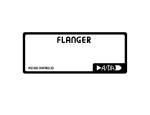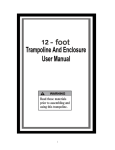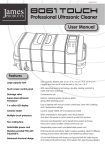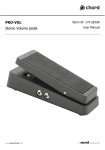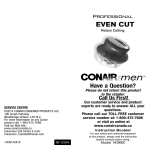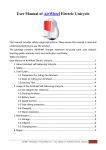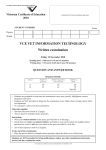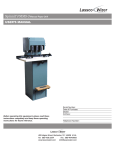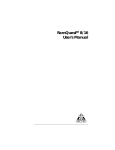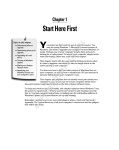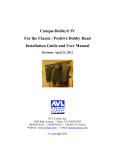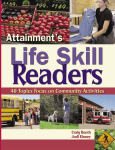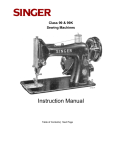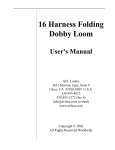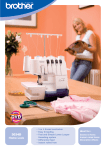Download ORCHID FASHION DESIGN: OHS POLICIES AND
Transcript
ORCHID FASHION DESIGN: OHS POLICIES AND PROCEDURES INDEX CUTTING ROOM Personal Safety Cutting Room Safety Using Machinery DUTIES Duties of employees Duties of employers OHS REPRESENTATIVES REPORTING ACCIDENTS USING EQUIPMENT Using a Blade Over-locker Safety Using equipment safely HAZARDS Furniture Slips and Trips Storage Manual Handling Noise Breaks Electrical Power CONTROLLING RISKS AT WORK EVACUATION HAZARDOUS SUBSTANCES WATCHING OUT! SEWING ROOM Sewing room safety Personal Safety Ergonomics Feet Positions CUTTING Connect training group: Version 1: July 2008: TAAENV403B Page 1 of 22 ORCHID FASHION DESIGN: OHS POLICIES AND PROCEDURES Personal Safety: To ensure your personal safety, you should make sure you do the following. Ensure that long hair is tied back and beards are trimmed to prevent them being caught in the moving parts of machinery. Remove any jewellery that dangles loosely from you, including watches, necklaces, bracelets and earrings. Wear tight/semi-fitting clothes as loose or baggy clothing can become caught in machinery. Use mesh gloves to prevent accidental injury when using powered cutting equipment. Use dust masks when working in the cutting room as cutting produces a lot of dust and lint, and some fabrics contain chemicals such as pesticides. Do not smoke, eat or drink in the cutting room. Do not talk when operating machinery in the cutting room. If you need to Connect training group: Version 1: July 2008: TAAENV403B Page 2 of 22 ORCHID FASHION DESIGN: OHS POLICIES AND PROCEDURES talk, turn the machine off. Follow correct manual handling procedures when you need to lift or move heavy rolls of fabric or cutters onto the cutting table. Cutting Room Safety: There are a number of ways you can make sure that the cutting room is a safe working environment. Divert people traffic from the cutting tables, using clearly marked paths. The cutting table should be stable and at a height appropriate for the cutter - 90cm is an average height. The work area floor should be non-slip and cleared of all fabric scraps and obstacles. Make sure there is good ventilation in the cutting room because cutting produces a lot of dust and lint, and some fabrics contain pesticides. Lay a single smooth sheet of paper between the fabric lay and the cutting table. This lets you move the fabric accurately and safely. Use weights or clamps to keep the fabric from moving and to maintain the accuracy of cutting. Fire extinguishers should be present and clearly marked and maintained. Make sure you know how to operate the fire extinguisher. Also, make sure you know who the fire warden at your workplace is and how to get in touch with him or her. This information needs to be clearly displayed in the work area so that everyone can see it. Make sure that an up-to-date first aid kit is available and that at least one person is trained in first aid. The name and location of the person should be clearly displayed in the work area so everyone can see it. Connect training group: Version 1: July 2008: TAAENV403B Page 3 of 22 ORCHID FASHION DESIGN: OHS POLICIES AND PROCEDURES Using Machinery: Electrical cables should be placed overhead and securely tracked. Never place cables across the table or floor Electrical cables should be maintained on a regular basis by a qualified electrician Do not leave cutting machines unattended or running while you are doing other tasks Check machinery regularly and remove lint and fluff in the base plates and castors Follow manufacturer's directions for oiling and lubricating machine parts. Take care when oiling as oil can stain or mark fabric The guards need to be positioned to protect the operator, but also allow the machine to move freely with minimum fabric movement. Use guards when cutting: o o The rear guard that covers the balance wheel should always be kept closed The foot guard, around the blade, should be fully down, just above the fabric plies Sharpen blades regularly. Blunt blades can damage fabric and also cause accidents. Use sharpening blocks or emery wheel located on the machine, but be careful of sparks. Do this during and between cutting sessions and replace sharpeners regularly as they wear out When a new blade is fitted, test it and sharpen it. Remember that the blade should face away from the operator Keep objects and your hands away from the path of the machinery. Otherwise, accidents can occur. Connect training group: Version 1: July 2008: TAAENV403B Page 4 of 22 ORCHID FASHION DESIGN: OHS POLICIES AND PROCEDURES DUTIES Duties of employees: You must take reasonable care of your own health and safety at work and avoid harming the health and safety of other people. Your general duties include: Following health and safety policy and procedures. Wearing protective clothing, accessories and grooming yourself appropriately. Maintaining equipment and operating it correctly. Reporting hazards. Reporting work-related injuries or harm to health. Co-operating with employers so that employers are able to carry out their duties under the OHS Act. Connect training group: Version 1: July 2008: TAAENV403B Page 5 of 22 ORCHID FASHION DESIGN: OHS POLICIES AND PROCEDURES Duties of Employers: Employers must provide and maintain a working environment where employees are not exposed to hazards. As an employer, the duties include: Having OHS policy and procedures that workers are required to follow. Providing OHS information, instruction, training and supervision. Consulting and co-operating with employees and OHS officials. Protecting employees from hazards. Ensuring a safe work environment, including all substances used. Reporting of accidents. OHS REPRESENTATIVES: OHS representatives are required to: Inspect the workplace. Connect training group: Version 1: July 2008: TAAENV403B Page 6 of 22 ORCHID FASHION DESIGN: OHS POLICIES AND PROCEDURES Investigate accidents and dangerous occurrences. Investigate risk of serious injury to, or harm to the health of, any person. Keep informed on current occupational safety and health information. Report hazards to the employer. Refer matters to the occupational safety and health committee (if present in your workplace). Consult and co-operate with the employer. Liaise with employees. REPORTING ACCIDENTS: Even though you have been maintaining OHS standards, sometimes accidents may still occur. At Orchid you are required to fill out an 'incident report' and then pass it on to the OHS representative. Remember you should report all: Connect training group: Version 1: July 2008: TAAENV403B Page 7 of 22 ORCHID FASHION DESIGN: OHS POLICIES AND PROCEDURES incidents, injuries, hazards, and near misses. You should: 1. Contact your designated OHS representative, first aid officer or supervisor immediately. 2. Attend to the person. 3. Fill out an incident report. Your OHS representative should supply you with one. 4. Hand the form in to your OHS representative who will make copies for themselves, the affected person and the supervisor of the section. 5. The OHS representative meets with the supervisor and other management to determine how they could avoid this happening again. 6. The OHS representative makes changes or puts procedures in place to ensure this doesn't happen again. Connect training group: Version 1: July 2008: TAAENV403B Page 8 of 22 ORCHID FASHION DESIGN: OHS POLICIES AND PROCEDURES EQUIPMENT Using a Blade: How to hold a retractable blade when opening a box: The blade must be retracted into the blade housing when not in use. The point of the blade should be directed away from the body, but run parallel to the body when the tape is being split. At the end of a job and when passing the knife to another person the blade must always be retracted into the casing. Overlocker Safety When using the over- locker you should follow the following safety precautions. The over-locker has a cutting blade that trims the edges of the fabric as it sews. Keep your fingers away from the blade to avoid cutting yourself. Make sure you close both the side and looper covers while over-locking. The covers should only be opened while threading or cleaning. Connect training group: Version 1: July 2008: TAAENV403B Page 9 of 22 ORCHID FASHION DESIGN: OHS POLICIES AND PROCEDURES Ensure the needle cover is in the correct position when over-locking because a broken needle could fly up and hit you in the face. The over-locker should be powered down and turned off at the power socket whenever you need to change the cutting blade. Using equipment safely: When you begin using any type of machinery it may involve some hazards that you need to be aware of first. If you become familiar with the machinery, it will help you to understand the way it needs to be handled. You can do this by: Reading the user manual before turning on the machinery. Asking the head cutter/machinist or your supervisor questions. Being properly trained in the use of the machinery. Maintaining your machinery. Connect training group: Version 1: July 2008: TAAENV403B Page 10 of 22 ORCHID FASHION DESIGN: OHS POLICIES AND PROCEDURES Reporting faults, problems or damages immediately to your supervisor. HAZARDS A hazard is anything that is likely to cause an injury or harm your health. Here are some examples of hazards which might exist in clothing production. Furniture The sharp edge of a damaged fixture could cut you. A table that is too low or too high can end up hurting your back if you use it to cut out on regularly. Slips and trips Liquids on the floor could cause someone to slip and fall. An electrical cord that is lying loose across a floor could cause someone to trip and fall. Connect training group: Version 1: July 2008: TAAENV403B Page 11 of 22 ORCHID FASHION DESIGN: OHS POLICIES AND PROCEDURES Storage Merchandise must not be stored any closer than 500mm from sprinkler heads. Poor stacking can cause accidents. An emergency exit that is blocked by stock is a hazard, especially if there is a fire situation. Objects left in walkways is a hazard. Manual handling A heavy box can cause you to injure your back when you try to lift it. Connect training group: Version 1: July 2008: TAAENV403B Page 12 of 22 ORCHID FASHION DESIGN: OHS POLICIES AND PROCEDURES Noise Noise levels should be kept to a minimum. Loud noises can be distracting, cause muscle tension, increased heart rate or even stress. You may not hear instructions or faulty machinery and in the long term you could get industrial deafness. Conversations should be kept to a minimum. If you need to talk, turn off any machinery that you are using. Being distracted causes loss of concentration and sometimes accidents. Breaks Eating and drinking should not take place in the machining room. Move to your lunchroom or designated area for your lunch and morning tea. Spillages may be dangerous and could damage the clothes you are sewing. Smoking should not take place indoors at any time. Move outside to the designated smoking area if you need to smoke. Connect training group: Version 1: July 2008: TAAENV403B Page 13 of 22 ORCHID FASHION DESIGN: OHS POLICIES AND PROCEDURES Electrical power You should ensure regular maintenance of electrical cords, cables, power points or switches by a qualified electrician. It is against the law for you to attempt fixing electrical problems. Frayed electrical cords are a hazard and could cause an electric shock. An overloaded power point could cause an electric shock. A loose power cord running across a table could cause an electric shock if you accidentally cut through it with your cutting machine. CONTROLLING RISKS AT WORK After you have identified hazards within the workplace, steps need to be taken to lessen the chance of accidents happening. This is called risk control. If you saw a puddle of oil on the floor, would you just step over it, or leave it for someone else to slip in? No! Instead you should: clean it up, or report it to your supervisor, who should organise the cleaning. Following these risk control measures means that you have controlled the risk of a potential accident. The chart below gives examples of hazards, risks and risk control measures. Connect training group: Version 1: July 2008: TAAENV403B Page 14 of 22 ORCHID FASHION DESIGN: OHS POLICIES AND PROCEDURES Hazard Long hair Loose clothing/accessories Risk May get caught in equipment. Could get caught in equipment. Exposed feet Sharp or heavy objects could be dropped on your feet or you could stub your toes. They are not very stable so you may fall over and twist your ankle. You could breath in the fibres which can cause breathing difficulties. Can be distracting and cause stress. This could result in an accident. Can result in trips, slips and falls. May result in eyestrain. High heels Floating fibres Loud noises Cluttered walkways/work areas Inadequate lighting Sitting incorrectly Can cause muscle strain and tension. Eating/drinking/smoking Cigarettes and spillage of food/drink may cause burns. Lifting Could cause back strain and muscle damage. Extreme temperatures May result in burns, heat stress, heat stroke or frostbite. Electricity May cause burns, shock or even death. Risk control Tie hair back. Wear close fitting, but comfortable clothing. Avoid wearing accessories. Wear covered in shoes that are medium to heavy weight. Wear a low, sturdy heel. Wear a dust mask. Turn down the volume or wear earplugs. Clear walkways and work areas of all clutter. Use a combination of both artificial and natural light. Use an adjustable chair that allows height and back adjustment. Eat, drink and smoke only in the designated areas. Practise proper lifting procedures. Arrange work times to coincide with the best climatic conditions, spend short periods in areas of extreme temperature, install airconditioning. Cords should not be loose; they should be fixed securely, electrical equipment should be properly maintained, power points should not be overloaded and should be switched off when performing maintenance. EVACUATION Evacuating a building quickly and efficiently in the case of a fire or emergency is crucial to ensure your own safety. When you start working at a company, you should be informed of the emergency evacuation procedures and where you should gather. Quite often, companies will have fire drills on a regular basis to test that the procedures they have put in place are adequate. Let's take a look at the emergency evacuation procedure we use here at Orchid. Remember that other companies may have their own set of procedures to follow when an alarm is sounded. Connect training group: Version 1: July 2008: TAAENV403B Page 15 of 22 ORCHID FASHION DESIGN: OHS POLICIES AND PROCEDURES 1. The alarm is sounded. 2. Stop work immediately. 3. If you are operating a machine, turn it off at the on/off switch. 4. Gather readily accessible valuables. 5. Exit the building in an orderly manner. 6. Proceed to the allocated muster point. Connect training group: Version 1: July 2008: TAAENV403B Page 16 of 22 ORCHID FASHION DESIGN: OHS POLICIES AND PROCEDURES 7. Report to the designated OHS representative/officer. This is very important to make sure that everyone has left the building safely. 8. Do not move from muster point until the all clear signal has been sounded or the roll has been called. HAZARDOUS SUBSTANCES A hazardous substance can be anything that can potentially harm the health of employees or other persons, including unborn children, at work. Amongst other things, a hazardous substance can be: natural, artificial, solid, liquid, or or powder. Most workplaces will use hazardous substances in one form or another, and any one work place may use many different hazardous substances. Examples of hazardous substances include: industrial chemicals, cleaning products, pesticides, paints, glues, garden chemicals, hair products, and synthetic mineral fibres (e.g. fibreglass). Connect training group: Version 1: July 2008: TAAENV403B Page 17 of 22 ORCHID FASHION DESIGN: OHS POLICIES AND PROCEDURES Hazardous substances can have the following short-term effects: dizziness, itchy skin, burns, and nausea. Long term effects can potentially cause: cancer, dermatitis, occupational asthma, eye irritation, or headaches. It is your responsibility to identify hazards if you notice any. This ensures that both you and your fellow workers are safe from possible injury. You can identify hazards by: checking injury records, inspecting the workplace, speaking to other employees, and checking regulations, codes of practice and other publications. WATCHING OUT If you see anything that is likely to cause an accident then you should tell your supervisor, the production manager or your health and safety representative immediately. You can assess the risk created by each hazard by asking yourself: Who is exposed? How much are they are exposed? How might they be affected? You can control the risk by: 1. Eliminating the hazard. For example, mopping up a slippery wet floor or repairing a sharp edge on a piece of furniture. Connect training group: Version 1: July 2008: TAAENV403B Page 18 of 22 ORCHID FASHION DESIGN: OHS POLICIES AND PROCEDURES 2. Substitution. For example, replacing the cutting table with one that is a more suitable height for the cutter. 3. Isolating the risk. For example, fencing off an area where a hazard exists. 4. Using engineering controls. For example, guards on machinery or exhaust ventilation. 5. Administrative. Changing work practices. For example, changing the process for cutting out to one that is safer for the cutter and other workers. 6. Using protective clothing and equipment. For example, wearing a protective mask and mesh gloves. Connect training group: Version 1: July 2008: TAAENV403B Page 19 of 22 ORCHID FASHION DESIGN: OHS POLICIES AND PROCEDURES SEWING Machine Room Safety What you wear isn't the only important thing you need to think about. You should also be aware of the hazards in the machining room. Make sure you follow these guidelines to help maintain safety while you are working in the machining room. Recognise that these machines work at very high speeds - which means accidents, can occur very quickly. Make sure scissors are placed in a secure position because falling scissors may result in piercing of the skin. Be aware of the exposed moving parts of machinery/equipment. For example: needles moving up and down, cutting blade on an over-locker moving up and down, and balance wheel revolving. You wouldn't want to get caught up in moving parts. Use a needle guard on the industrial machine to avoid piercing your fingers with the needle. Connect training group: Version 1: July 2008: TAAENV403B Page 20 of 22 ORCHID FASHION DESIGN: OHS POLICIES AND PROCEDURES Switch off your industrial machine when: threading, changing needles, and doing any maintenance. If you don't turn it off, you could accidentally press the treadle and the machine would start sewing. Machinery should not be left running and unattended. If you are doing another job or have been called away, turn off your machine. Feed the fabric through the industrial machine with your hands at the sides of the foot - not in front. This will prevent your fingers being sewn. Personal Safety: When you are working in the machining area of a clothing manufacturer, you need to take into consideration the type of clothing, shoes and accessories that you need to wear. As you will be working with different types of machinery and equipment that have moving parts or sharp points you will need to make sure that: nothing can get caught in any moving parts, your feet are protected at all times, and eye and fibre protection is used when necessary. Ergonomics: There are a number of different factors to consider in relation to the correct posture when sitting at a sewing machine. How do you know which factors you need to consider? You can use guidelines to help you maintain your body, and chair, in a proper position. Remember the incorrect choice of chair and the way you sit when machining may result in: poor posture, muscle tension/stress, and cramping Foot Positions: Connect training group: Version 1: July 2008: TAAENV403B Page 21 of 22 ORCHID FASHION DESIGN: OHS POLICIES AND PROCEDURES The sewing machine treadle controls the speed of the sewing machine, and correct placement of your feet on the treadle will give you more control over your machine. Positioning feet on the treadle Your feet should be positioned on the treadle in the following way: Low speed Lightly depress the front part of the foot pedal. High speed Further depress the front part of the foot pedal. Idle position Depending on the type of machining technique you are using, the speed may vary between slow and fast. This will depend on your individual skills. Presser foot lifting Lightly depress the heel onto the back part of the pedal to raise the presser foot. Thread trimming Fully depress the back heel of your foot onto the pedal which will provide auto cut off. Connect training group: Version 1: July 2008: TAAENV403B Page 22 of 22






















